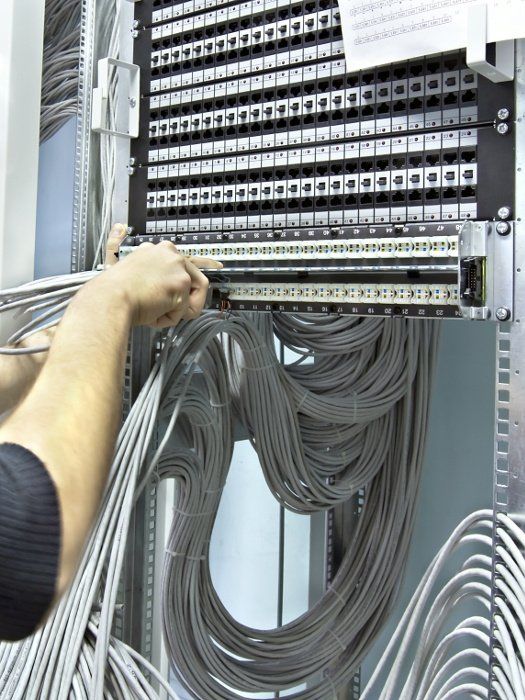Structured Cabling in Commercial Construction. In the process of constructing a commercial building, most general contractors hire dozens of subcontractors and sometimes sub-subcontractors to get through the job. At G. S. & S. Construction, we “self-perform” a lot of the work and use only trusted subcontractors for the most specialized aspects of the project.
One of the most overlooked and least understood of these specialized contractors is the structured cabling contractor. However, in terms of the day-to-day functioning of a modern office building, they might just be one of the most important contractors involved in a project. Let’s take a close look at the role this specialist plays in a construction project.
What is structured cabling?
Structured cabling is an infrastructure of cables for voice and data communications that include telephone, internet, and network connectivity systems.
Structured cabling has one point of origin or connection for the entire system. Other units are added to the system as needed. This allows you to have a central hub where all changes to the system and maintenance can take place. This is very important in an office building or other heavily wired space where reliable connectivity is critical.
Consequences of poor structured cabling design
If the IT infrastructure in a building is poorly designed or poorly installed it will lead to valuable resources being wasted, unnecessary costs, and frustrating down time.
Among other issues, poor structured cable IT infrastructure can lead to:
- Intermittent faults, which are some of the most common issues with poor IT Infrastructure design and installation. Malfunctioning connections and faulty patch leads are usually the cause, but identifying the culprit lead or outlet can be difficult in a poorly designed system.
- WiFi issues are plentiful with poor IT infrastructure. If the devices are installed in the wrong position it leads to poor coverage. Using devices in your system with conflicting WiFi standards can lead to a hose of challenges.
- Not hiring a quality structured cable contractor may result in mismatched cabling. A structured cable network that uses inconsistent materials in the network will result in the electrical mismatches and other issues that are difficult to identify and hard to fix.
- Structured cable networks tend to get disorganized over time if the system is poorly designed or when different companies are called in to do maintenance, repairs, or upgrades. This disorganization leads to sloppy workmanship, untidy wires, and inaccurate labeling.
What does a structured cabling contractor do?
Structured cable contractors design, install, and maintain a cable system that best meets your voice and data communication needs. They consider your immediate requirements as well as potential future needs in the design and installation.
Having a properly designed network is vital to a successful business. Hiring a reliable structured cabling contractor and installing a properly designed system has many benefits, including:
- Creating an organized and logical cable infrastructure that works efficiently and eliminates the “tangles nest” of wires problem.
- Better wire and system organization means better airflow and less risk of crushed cables. Improved airflow reduces cooling costs, saving you money in the long run.
- Well-organized structured cable systems make future upgrades, additions, and other changes much easier and potentially cheaper.
- Well-designed cable systems prevent network downtime and make troubleshooting and repairs easier when there is a problem.
What qualifications does a structured cabling contractor need?
The gold standard in the structured cabling industry is a Registered Communications Distribution Designer (RCDD) certification from the BICSI (Building Industry Consulting Service International). A contractor with this certification holds the highest level of training available to any structured cabling contractor.
BICSI RDD training exceeds most local and regional certification requirements. BICSI also requires continued education to maintain certification. BICSI RDD certified contractors must also pass compliance tests on local and international codes, industry best practices, and safety procedures. So, hiring a BICSI certified contractor nearly guarantees high quality work.
In addition to the RDD certification, some states require contractors who work on security camera systems and access control systems to have a license. These systems are often part of a building’s structured cabling system and thus may be designed and installed by structured cabling contractors.
When it comes to installing a structured cable system, a good contractor is worth their weight in gold. It will make your building far more efficient and prevent many unnecessary maintenance and repair issues in the future. Hiring and supervising these skilled specialists is all part of the behind-the-scenes work that we do every day on projects across the St. Louis Region.
The post The Role of Structured Cabling in Commercial Construction appeared first on G. S. & S. Construction.





